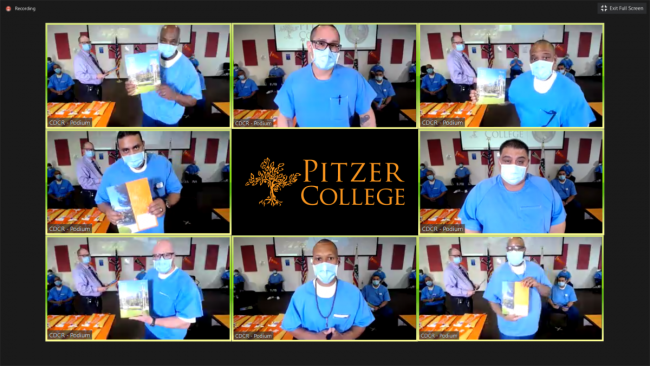You have /5 articles left.
Sign up for a free account or log in.

Incarcerated students receiving their admissions to Pitzer's new B.A. program.
Pitzer College
All but one of California's 35 prisons offer associate transfer degrees through local community colleges for incarcerated students.
Those students have been clamoring for opportunities to pursue a bachelor's degree while incarcerated, said Rebecca Silbert, senior director of the Rising Scholars Network, part of the Foundation for California Community Colleges.
Now, Pitzer College, one of the private liberal arts institutions that make up the Claremont Colleges, is offering a bachelor's degree in organizational studies through its Inside-Out program.
Inside-Out programs bring students from a college ("outside" students) into a prison facility to be taught in tandem with incarcerated students ("inside" students). Professors must receive special training to teach these kinds of classes.
This will be the first Inside-Out program to offer a full degree, said Nigel Boyle, professor of political studies at Pitzer and the director of its Institute for Global/Local Action and Study.
The model lets Pitzer offer free college courses, and now a degree, to incarcerated students without losing too much revenue, as professors are teaching tuition-paying students at the same time.
The college already offers one-off Inside-Out courses. They're some of the most popular courses at Pitzer, both among faculty members and students, Boyle said.
One incarcerated student had taken 11 Inside-Out courses through Pitzer. Boyle realized it was time to move to the next step of formalizing a bachelor's degree track.
Pitzer worked with Norco College, a nearby community college, to create a pipeline for incarcerated students at the California Rehabilitation Center. Those who had already earned associate degrees and who were scheduled for release within 10 years could apply for the Pitzer program. Nearly 20 applied, and 10 were chosen for the program. One student chose to pursue a different program offering firefighter training, and another was transferred to a federal institution, so the first cohort has eight incarcerated students.
Damian Busby, 51, is one of the incarcerated students in the first cohort. He has earned six associate degrees while in prison and hopes to earn a terminal degree in math or physics. Pitzer's Inside-Out courses have given him a sense of belonging, Busby wrote to Inside Higher Ed. Busby is an Indigenous member of the Pine Ridge reservation and always thought his opportunities were limited, but now he feels more confident in pursuing his goals.
Reggie Bullock, 37, another incarcerated student, said pursuing education has given his life meaning. Bullock didn't care before if he lived or died, but now he believes he can be an agent of change after earning a degree, he wrote.
Several other incarcerated students wrote about the meaningful experiences they have in their courses, and how important the attention and care they receive from professors is.
"I don't believe that I have ever been the consistent focus of such precious attention and resources," wrote Yusef Pierce, 33. In addition to receiving time with professors, incarcerated students also receive mentorship from those who work in the program.
Boyle believes the barrier to entry for this type of program is relatively low. Faculty are teaching the classes they normally would, just in a different setting with two different groups of students.
"There are other wonderful prison programs, but they require massive amounts of philanthropic support," he said. "This is something where other institutions, particularly if they’re willing to collaborate with one another, could really just get moving here."
After this pilot is complete, Pitzer will assess the program and choose whether to continue it. It may offer a degree in a different subject, based on what incarcerated students are interested in.
"We’ve taught everything from dance to chemistry through Inside-Out," he said.
Prison education is a hot topic in higher education. Nearly 95 percent of those incarcerated in federal and state prisons will one day be released, and many argue those people's lives, and society at large, would be better off if they had access to education during their sentences.
Research shows that those who pursue education while incarcerated are more likely to be employed and earn higher wages after release than those who don't. Recidivism rates are lower for those who pursue education while in prison. A $1.4 trillion budget deal to fund the government through September includes provisions to allow more incarcerated students to have access to federal Pell Grants.
Boyle sees the program as just him doing his job as a professor.
Outside students get an eye-opening learning experience, which Boyle compared to studying abroad. If the college wants to teach students about mass incarceration and its implications, students need to "get proximate," he said, and get beyond stereotypes.
Inside students get tuition-free credit toward courses or a degree. Both groups get to learn from each other.
"It’s important ethically," he said. "But I’m not looking to save souls. It is not philanthropic. I’m doing my job."
Milly Chi, a junior at Pitzer studying organizational studies and Asian American studies, has taken two Inside-Out classes and only had good things to say.
"The word that comes up is 'transformative,'" Chi said. "As an outside student, my experience was really transformative because I was meeting a lot of individuals from different walks of life. Part of what really brought us together is you can feel a very strong sense of investment in our education and our learning. We know this isn’t an opportunity we can take for granted because there’s so much work to make these classes possible."
Neither Chi nor any members of her family have ever been incarcerated, so she didn't know what to expect when she first went to the prison, she said.
"I knew I would be surrounded by people who were passionate about learning," she said. The class ended up pushing her to be more vulnerable, as many of her peers were willing to share sensitive parts of their lives.
She also appreciated the opportunity to hear different points of view. For example, the students discuss the admissions scandal involving Lori Loughlin and Olivia Jade Giannulli. The outside students blamed Loughlin's privilege for her actions and said it was unforgivable. But the incarcerated students said they didn't feel Loughlin should go to jail.
"What they see from the story is the lengths that Lori would go out of love for her daughter," Chi said. "Seeing the compassion that inside students had for this was moving."
Many faculty members prefer Inside-Out courses because of their intensity, Boyle said. Students can't bring phones into the prison. Incarcerated students highly value their education, so they hold Pitzer students accountable with being prepared.
"It creates an unusually intense learning experience," he said.
Costs to the college are marginal. A $50,000 grant from the Bernard and Audre Rapoport Foundation helped the college create extra sections of organizational studies courses, to ensure Pitzer students had enough access. A $1.1 million grant from the Andrew W. Mellon Foundation let Pitzer expand its programming and create a smart classroom at the prison so incarcerated students could get laptops and internet access. The college covers transportation costs to the prison and provides books for incarcerated students, Boyle said.
Pitzer is working on creating avenues for support for incarcerated students that are equivalent to what outside students receive. For example, a professor will be training some incarcerated students to become peer coaches for a prison-based writing center. Students at Pitzer also vote on the decisions the college makes, via student voting members in the College Council -- include whom to give tenure to -- so the program is working on ways to involve incarcerated students in those decisions now that they are full degree-earning students, Boyle said.
Most experts agree that any program that expands options for those in prison is generally good. But there are some potential downsides to the Inside-Out model.
"One of the potential dangers of an Inside-Out-focused model is there’s the potential that things get geared toward campus students, and their engagement with incarcerated students gets treated as this extra benefit for their learning, rather than incarcerated students being treated as equals with outside students," said Ruth Delaney, program manager at the Vera Institute of Justice.
If not done intentionally, Inside-Out programs have the potential to be exploitative, she said.
"We're very aware of that," Boyle said. Outside students need to seek permission from instructors to register for these classes, he said. Faculty members interview each student to see why they want to take the course. Students also go through an orientation before starting the course.
"The outside students are there to learn. We try to reinforce that their job is to be a good student in this class," he said. "It's not intended to be an exotic experience."
The goal, Boyle said, is to encourage students to reflect on mass incarceration in the U.S. and what it means. Pitzer wants them to become activists, he said.
A major positive point of this model is that incarcerated students will receive the same quality of instruction as campus students, as they're sharing the same faculty member and pedagogy.
"One thing that’s very difficult about prison education programs is making sure that those students are really getting good interaction, having a good classroom experience," said Clare McCann, deputy director for federal higher education policy at New America. "This is both a good way to make sure students in prison are getting access to high-quality education, but also to open some new opportunities and create some interesting dynamics."
But it's likely not replicable everywhere, at least at scale, Silbert said. Community colleges in California don't use the Inside-Out model in prisons, and they likely couldn't. The state has 100,000 incarcerated people, and community colleges teach about 6,500 students every semester -- and there are waiting lists in every prison.
"We have so much demand and so much need," she said. "It will take all of us working together to make sure that we’re being student-centered. The more the merrier, really."




